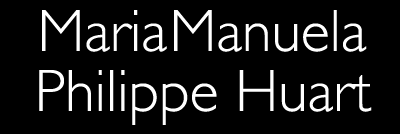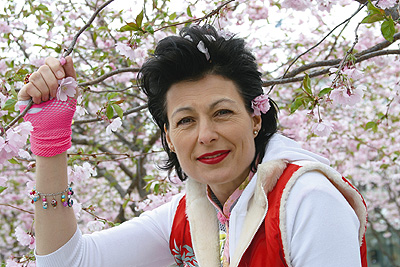




 Maria Manuela’s pictures define the contrasts between the culture of the Far East and the western world’s pop-culture at the same time as they bring the two forms together. She derives her inspiration from classic Japanese woodcuts and their motifs of fantastically coiffured, cherry-lipsticked women, dressed in exquisitely patterned kimonos. But what she presents for the viewer are modern young Japanese women in mini-skirts, dancing among the cherry blossom and haiku poems. Maria Manuela’s pictures define the contrasts between the culture of the Far East and the western world’s pop-culture at the same time as they bring the two forms together. She derives her inspiration from classic Japanese woodcuts and their motifs of fantastically coiffured, cherry-lipsticked women, dressed in exquisitely patterned kimonos. But what she presents for the viewer are modern young Japanese women in mini-skirts, dancing among the cherry blossom and haiku poems.
 Her Pop Icons are painted in vinyl on linen canvas – layer upon layer laboriously laid down to achieve the effect of a printed, japanned surface. The lines of the lips, the semi-circular contours of the eyes and the billowing coiffures are expressed against a monochromatic background. Her advertisement-like images combine mystique with unequivocal simplicity, setting a stage for all manner of different facial expressions – melancholy, pensive, jovial. Her Pop Icons are painted in vinyl on linen canvas – layer upon layer laboriously laid down to achieve the effect of a printed, japanned surface. The lines of the lips, the semi-circular contours of the eyes and the billowing coiffures are expressed against a monochromatic background. Her advertisement-like images combine mystique with unequivocal simplicity, setting a stage for all manner of different facial expressions – melancholy, pensive, jovial.
 Born in Stockholm in 1959, Maria Manuela Vintilescu’s first serious encounter with art came at the age of seven. It was with fascination that she viewed Niki de Saint-Phalle’s giant sculpture She, then displayed at the Museum of Modern Art in Stockholm. After graduating from the Ecole Française in Stockholm, Maria took courses in painting, drawing and advertising. After ten years as a scene painter in the theatre, she turned to her own art. Her Pop Icons appeared for the first time in 1998. Two years later her Flower Year suite was exhibited in the Stockholm Spring Show at Liljevalch’s Gallery. These twelve female portraits were published in booklet form accompanied by Japanese haiku poetry interpreted by her father, Jan Vintilescu. It was his book that had first introduced this Japanese lyric form to a wider audience of Swedes in 1959. Born in Stockholm in 1959, Maria Manuela Vintilescu’s first serious encounter with art came at the age of seven. It was with fascination that she viewed Niki de Saint-Phalle’s giant sculpture She, then displayed at the Museum of Modern Art in Stockholm. After graduating from the Ecole Française in Stockholm, Maria took courses in painting, drawing and advertising. After ten years as a scene painter in the theatre, she turned to her own art. Her Pop Icons appeared for the first time in 1998. Two years later her Flower Year suite was exhibited in the Stockholm Spring Show at Liljevalch’s Gallery. These twelve female portraits were published in booklet form accompanied by Japanese haiku poetry interpreted by her father, Jan Vintilescu. It was his book that had first introduced this Japanese lyric form to a wider audience of Swedes in 1959.
 In much the same way as the haiku moves us by the eloquence of its brevity, Maria Manuela seeks through her pictures to convey situations, facial expressions and frames of mind by the most sparing and subtle of means. Her father had sought the same in rendering the haikus of the Japanese poet Issa (1763–1828) In much the same way as the haiku moves us by the eloquence of its brevity, Maria Manuela seeks through her pictures to convey situations, facial expressions and frames of mind by the most sparing and subtle of means. Her father had sought the same in rendering the haikus of the Japanese poet Issa (1763–1828)
 Seeing cherry trees Seeing cherry trees
 in the blossomed parks of spring in the blossomed parks of spring
 strangers become friends. strangers become friends.


 A jasmine blossoms with explosive power in one of Philippe Huart’s paintings. Mickey Mouse sports a black suit with a lemon-coloured bow tie. The text “I have a dream!” appears on the canvas, letting Martin Luther King’s famous words echo through the work. In another painting Huart has enlisted Spiderman on a dangerous mission. A jasmine blossoms with explosive power in one of Philippe Huart’s paintings. Mickey Mouse sports a black suit with a lemon-coloured bow tie. The text “I have a dream!” appears on the canvas, letting Martin Luther King’s famous words echo through the work. In another painting Huart has enlisted Spiderman on a dangerous mission.
 Philippe Huart gives form to both the familiar and the unexpected simultaneously. He observes the world around him in much the same way as pop artists Andy Warhol and Roy Lichtenstein did through their advertisements and comic strip characters. Thus, fragments of well-known trademarks and logotypes are found in, for example, his offbeat series of paintings entitled Trademark. Some of his motifs are taken from ads for soft drinks, burger bars and car tyres. Philippe Huart gives form to both the familiar and the unexpected simultaneously. He observes the world around him in much the same way as pop artists Andy Warhol and Roy Lichtenstein did through their advertisements and comic strip characters. Thus, fragments of well-known trademarks and logotypes are found in, for example, his offbeat series of paintings entitled Trademark. Some of his motifs are taken from ads for soft drinks, burger bars and car tyres.
 This places Huart in a new wave developing in France over the last decade, the so called Pop français or Pop nouveau school. This places Huart in a new wave developing in France over the last decade, the so called Pop français or Pop nouveau school.
 Born in Clamart, France, in 1953, Philippe Huart has been living and working in Paris for many years. After studying graphic arts and graduating from art school, he decided in 1991 to become an artist full-time. His debut, however, had already preceded this decision by eight years, when his works were exhibited at the 1983 Salon Jeune Peinture in Paris. Since then he has taken part in around 50 exhibitions, both solo and shared, although this is the first time that his work has been shown in Sweden. Born in Clamart, France, in 1953, Philippe Huart has been living and working in Paris for many years. After studying graphic arts and graduating from art school, he decided in 1991 to become an artist full-time. His debut, however, had already preceded this decision by eight years, when his works were exhibited at the 1983 Salon Jeune Peinture in Paris. Since then he has taken part in around 50 exhibitions, both solo and shared, although this is the first time that his work has been shown in Sweden.
 Signs warning about risks for fire and explosion are mixed with apricot-coloured female faces that segue into mint blue. Opposites are mixed as brutality blends with beauty in his paintings. Fragments are joined, forming dreamlike scenarios. Signs warning about risks for fire and explosion are mixed with apricot-coloured female faces that segue into mint blue. Opposites are mixed as brutality blends with beauty in his paintings. Fragments are joined, forming dreamlike scenarios.
Johan Persson 6 februari 2006 |